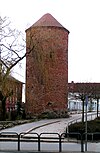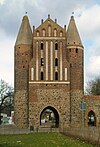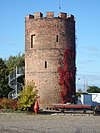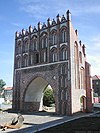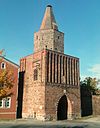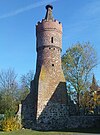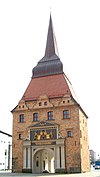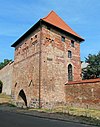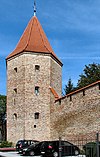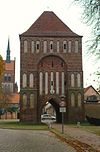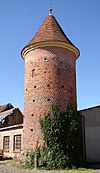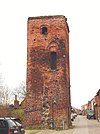List of city gates and defense towers in Mecklenburg-Western Pomerania
The list of city gates and defense towers in Mecklenburg-Western Pomerania lists all preserved city gates , city defense towers and waiting towers in front of the cities in Mecklenburg-Western Pomerania . Are not included Wiekhäuser and vestiges of the former city fortifications and towers of castles, fortresses and castles .
History of the city fortifications in Mecklenburg and Western Pomerania
Most of the city fortifications in Mecklenburg and Western Pomerania date back to the 13th or 14th century, but were expanded and redesigned many times until the 17th century. The best preserved city fortification is the almost completely restored, approx. 2300 meter long city wall of Neubrandenburg with four gates (three double gates) and a defensive tower, which are also among the main works of brick Gothic in architectural history . The Rostock city fortifications , the fortifications of Friedland (Mecklenburg) and the Stralsund city wall are also well preserved . All fortification towers in Mecklenburg-Western Pomerania are made of brick , only the base and the actual city wall are sometimes made of field stones . The fortifications of the Hanseatic city of Wolgast , the residential cities of Schwerin and Güstrow as well as other cities with a historical city center have completely disappeared, apart from some of the remains of the wall.
City gates
In addition to defense, the city gates also served to represent civic pride and almost all of them belong to the brick Gothic. Only a few gates such as the Rostock stone gate were later built or redesigned in the style of the brick renaissance . Romanesque gates have not been preserved. After the 16th century, only the neo-classical monk's gate was rebuilt in Rostock to replace an older gate. The typical gate rises on a square floor plan above the mostly ogival passage. In the 15th century, numerous city gates were raised to form gate towers . The architectural decorations - especially brick ornaments , partially whitewashed aperture , gables and pinnacles - located respectively on the city and the field side of the gates (ie the opposite side of the city..). While in Rostock, for example, the city side was richer, in Barth and Grimmen, for example, the field side facing the incoming visitor was more representative. The New Gate and the Stargarder Gate in Neubrandenburg are the only gates with figurative decorations.
There are still 33 city gates in total. Even if the number of preserved city gates in Mecklenburg-Western Pomerania is comparatively large, it is clearly exceeded by the number of lost gates. In Rostock there are still four of the 22 gates, two of the original ten Stralsund city gates have survived , in Wismar only one gate survived and of the Greifswald fortifications there is only one defensive tower besides the remains of the city wall. In the Middle Ages, the smaller cities usually had two to six city gates. In Neubrandenburg, Grimmen , Tribsees , Teterow , Pasewalk , Altentreptow , Malchin and Friedland two to four gates have been preserved, and one town gate can still be found in Demmin , Anklam , Barth , Loitz , Ribnitz and Usedom .
In the course of the industrialization and urban expansion in the 19th century, the 17/18. Century-decaying city fortifications systematically demolished as traffic obstacles. Another wave of destruction was the bombing of World War II . Unless the buildings were completely destroyed or fell victim to urban rebuilding plans in the post-war period, some of the ruins were not reconstructed or refurbished until the 1980s (such as the cow gate in Rostock). In 1960 the Rostock Petritor and the Stralsund Semlower Tor had to give way to traffic and urban planning considerations.
Defense towers, city walls and land defenses
In Mecklenburg-Western Pomerania there are still twelve defense towers and two upstream waiting towers. Cylindrical towers clearly dominated over square or polygonal ground plans. The simple defense towers were mostly preserved when they were used as " fishing towers ", that is, as prisons, as powder towers , i.e. as a magazine for gunpowder , or as a water tower . Without such a function, they were later demolished. Two waiting towers outside of Anklams and Parchims still bear witness to the land defenses upstream from the cities . No remnants of the Landwehr have survived from other cities, such as Güstrow . Only a few front gates and Zingel are preserved (Neubrandenburg, Malchin), kennels only in Neubrandenburg and the wooden battlements of the gate towers in no case. Most of the preserved, reconstructed or historically newly built Wiekhäuser are in Neubrandenburg and Friedland.
List of city gates and defense towers
In a number of cases it is difficult to give precise details of the construction time, as the gates have often been redesigned and expanded. The decisive factor is the construction phase in which the gate was given its current shape. First mentions usually only give a terminus ante quem , which only states when a building must have already existed, but not how long at that point in time. Sometimes it is also unclear whether a mention refers to today's gate or to a previous building.
| city | Surname | construction time | height | particularities | image |
|---|---|---|---|---|---|
| Altentreptow | Brandenburg Gate (Neubrandenburger Tor) | around 1450 | 25.80 meters | five-storey gate tower with city and field side gables and gable roof; led to (New) Brandenburg | |
| Altentreptow | Demminer Tor | around 1450 | 12 meters | previously multi-storey and with city and field side gables; today only as a single-storey, ogival passage building with four tower-like structures added in the 19th century; led to Demmin | |
| Anklam | Stone gate | around 1450 in its present form, first mentioned in 1404 | 32 meters | increased to today's height around 1450; led east to Usedom ; used as a city prison from the 16th to the 20th century; from 1986 expanded to a museum | |
| Anklam | Powder tower | 1462 | 20 metres | cylindrical defense tower, formerly with a conical tip and a projecting crenellated crown , which was destroyed in the Thirty Years War ; First mentioned in 1463 as Vangenturm , it served as a prison until the 16th century, later as a powder tower , and from 1860 to 1874 as an observatory | |
| Anklam | High stone | First mentioned in 1412 | 16 meters (20 meters with hill) | Part of the Anklamer Landwehr 3.5 kilometers outside the city center; cylindrical tower with a brick helmet; a watch tower first mentioned in 1412 | |
| Barth | Dam gate | around 1425; Previous building first mentioned in 1397 | 35 meters | multi-storey tower with eight-sided pyramid roof; secured the road to the west; Comprehensively renovated in 2007 | |
| Barth | Fishing tower | 16th Century | 12 meters | served as a prison, since 1965 school observatory | |
| Demmin | Luisentor (Cow Gate) | 14./15. Century, passage floor still 13th century | 31 meters | Ground floor still made of worked granite boulders , upper floors made of brick masonry, the first floor is decorated on the city side with three-part panels, in the arch of which there are three rosettes, the steep gable roof is bordered by stepped gables decorated with panels ; led east out of the city; served from 1768 to 1895 as the city prison and home of the prison guard; 1821 named after Wilhelmine Luise Princess of Anhalt-Bernburg; From 1952 to 2002 there was a youth hostel in the Luisentor; since summer 2007 guest house of the city of Demmin | |
| Demmin | Powder tower | Mentioned 1546, completed 1570–1571 | 13.80 meters | Defense tower south of the Luisentores in Demmin; first mentioned as "gloomy cellar"; Located next to the executioner's apartment, the tower also served as a prison until the mid-18th century | |
| Friedland | Neubrandenburger Tor (Burgtor) | second half of the 15th century | 25 meters | square gate tower with four polygonal corner towers with massive cone helmets; led to Neubrandenburg; Completely renovated in 1913; The Friedland Heimatmuseum is located in the gate | |
| Friedland | Anklamer Tor (formerly stone gate) | from 1304 | 23 meters | five-storey; At the side the square tower is flanked by round towers of the same height with bricked cone helmets; led to Anklam | |
| Friedland | Fishing tower | 14th Century | 35 meters | secured the crossing over the Datze in a north-westerly direction ; In the Thirty Years War the upper part of the tower was shot and not rebuilt, after which the tower was used as a prison; 1910 construction of a water tower ; Reconstructed in 1997 and converted into an observation tower | |
| Greifswald | Fan tower | between 1270 and 1280 | 13.50 meters | Defense tower; originally four storeys; used as a powder tower in the 18th century, observatory 1775–1826 ; Renovated at the end of the 19th century and provided with a battlement; today it is used by the harbor master of the museum harbor | |
| Greifswald | Ravenstorm | 13./14. century | cylindrical defense tower, only the basement is preserved | ||
| Grim | Stralsund Gate | around 1320 | 25.20 meters | erected on a field stone base; on the outside very extensive, on the city side much more simply decorated; led to Stralsund ; 1813 apartment of the court servant, until 1850 one room served as a prison; Badly damaged by a lightning strike in 1910 and restored in keeping with the original style; Extensively restored in 1978 | |
| Grim | Mühlentor (Tribseeser Tor) | around 1320 | 24.80 meters | named after a water mill that used to be there ; erected on a field stone base; led to Tribsees ; since 1987 part of the local history museum | |
| Grim | Greifswalder Tor (Loitzer Tor) | between 1350 and 1400 | 21.40 meters | led to Greifswald ; around 1800 a lightning strike completely destroyed the upper part of the gate, but not fully restored due to financial difficulties; Comprehensively reconstructed in 1980 | |
| Loitz | Stone gate | 14th Century | led southwest out of the city; Partially destroyed by fire in 1701, since then a simple residential building on the upper floor | ||
| Malchin | Stone gate (Malchin) | 14th Century; today's shape 1894 | 18 meters | Front gate of an earlier double gate with a monopitch roof and partially glazed tiles, the inner main gate was torn down in 1837; led south out of the city to Waren ; served as a prison until the 19th century; In 1893 the stone gate was released for demolition and sold, but in 1894 it was restored in neo-Gothic style | |
| Malchin | Kalensches Gate | 15th century | 14.50 meters | Front gate of an earlier double gate with a monopitch roof and partially glazed tiles, the inner main gate was torn down in 1837; led north out of the city to (Alt-) Kalen ; used as a prison until the 19th century; Restored in 1900 | |
| Malchin | Fishing tower | 15th century | 35 meters | Defense and watchtower; six-story brick building with a gable roof; a Renaissance gable was added in the second half of the 16th century; Renovated in 1996; served as a prison | |
| Neubrandenburg | Friedland Gate | third quarter of the 15th century; Previous building in the first half of the 14th century | 24.80 meters (main gate); Front gate: 13.80 meters; Zingel: 9 meters | Double gate system; Torburg with a total length of 88 meters; The main gate is a two-storey gate tower with a polygonal stepped gable; the entrance gate with a small gable roof between the pinnacles connected to the main gate by two walls; Half-timbered buildings between the two gates: the former gatekeeper and customsman's houses (new buildings from the 1970s); A zingel (fortification) in front of the field , the former connecting walls to the gate were demolished in the 19th century; led northeast to Friedland ; the gate complex was reconstructed and stylistically redesigned in the 19th century | |
| Neubrandenburg | Stargarder Tor (Wendish Gate) | 1311 | 24.50 meters (main gate); Front gate: 19.25 meters | Double gate system; the main gate on the city side adorned with nine adorantesses with pieces of terracotta ; between the two gates as a half-timbered building a gatekeeper house (newly built in 1982); led south to (castle) Stargard ; Gate complex reconstructed and stylistically redesigned in the 19th century | |
| Neubrandenburg | Treptower Gate | Mid-14th century; Front gate from the 15th century | 31.80 meters (main gate); Front gate: 14.80 meters | Double gate system; The complex includes a half-timbered house built in the 18th century (rebuilt in the 1970s) and the telegraph office established in 1856; led west to (Alten-) Treptow ; Since 1872 the regional museum Neubrandenburg has been located in the main gate | |
| Neubrandenburg | New gate | second half of the 15th century | 25 meters | originally the gate complex consisted of the main gate, front gate and gate; Vortor and Zingel fell victim to the siege of Tilly the year it was completed, 1631 ; Remnants of a later (classicistic) entrance gate was demolished in 1852 because it was dilapidated; on the city side of the main gate there are eight adorantesses ; the gate was reconstructed and stylistically redesigned in the 19th century; Since 1992 the New Gate has been the seat of the Fritz Reuter Society | |
| Neubrandenburg | Fangelturm (monk tower ) | Early 15th century | 25 meters | Defense tower built from a Wiekhaus to secure the city to the north to the Duchy of Pomerania ; served as a prison until the 19th century; because of the nearby Franciscan monastery also called "Mönchenturm" ; today's shape through reconstruction and reshaping in the 19th century; accessible as a lookout tower since the 1990s | |
| Parchim | Fishing tower | around 1360 | 10 meters | Watch tower; Part of the Parchimer Landwehr on the northern passage; outside the city, already standing in the area of the village Stralendorf ; referred to as the fishing tower since the beginning of the 19th century; Renovation in 2004 | |
| Pasewalk | Prenzlauer Tor | around 1450 | 25.60 meters | led south to Prenzlau ; Brick building on an older granite ashlar base, at the beginning of the 19th century the dilapidated stepped gables were replaced by a hilted gable roof ; today city museum | |
| Pasewalk | Mill gate | around 1450 | 25.10 meters | Square basement with an octagonal tower extension, the tower tapers gradually to the bricked pointed helmet | |
| Pasewalk | Kiek in de Mark | 1445 | 20.20 meters | From a square substructure, a cylindrical tower on the south side of the city wall, which ends in an octagonal brick helmet above a crenellated wreath | |
| Pasewalk | Powder tower | 15th century | 27.40 meters | cylindrical defense tower with octagonal brick tip and pewter wreath; served as a magazine for gunpowder | |
| Ribnitz-Damgarten | Rostock Gate | 15th century; 1290 first documentary mention of a previous building | in the Ribnitz district ; led west to Rostock ; Refurbished in 1981; until 2002 a street led through the gate | ||
| Rostock | Kröpeliner Tor | around 1265-1280; wooden previous gate around 1255 | 54 meters | initially two-storey, increased to five storeys around 1400; led to the important trade route to Wismar and Lübeck ; 1847 construction of a neo-Gothic porch, which was removed again in 1945; until 1960 a tram line ran through the gate; Restoration work took place 1966–1969; until 2004 seat of the Museum of City History; today the seat of the association "Geschichtswerkstatt Rostock eV" | |
| Rostock | Stone gate | 1574-1577; Predecessor gate 1279 | Main portal of the city; Razed in 1566 after the town had disputes with Johann Albrecht I , rebuilt in the Renaissance style after the First Rostock Inheritance Treaty ; Badly damaged by bombs in 1942, rebuilt 1950–1956 | ||
| Rostock | Cow gate | second half of the 13th century; 1325 first mention | 14 meters | four-storey; led to the road to Bützow and Werle ; from 1608 prison, later residential building; Partially reconstructed in 1938, badly hit by bombs in 1942; 1962–1964 the building got a roof again, in 1984 it was completely reconstructed; 1985 to 1990 seat of the Rostock district board of the GDR writers' association, until the end of 2009 seat of the Rostock literary house. Since the beginning of 2010 it has been the seat of the Rostock mediation office. | |
| Rostock | Monk gate | 1805/1806; 1316 first mention of the previous gate | only surviving beach gate to the city harbor ; the originally Gothic gate was renewed in the Renaissance style in the 16th century, a new, neo-classical gate was built in 1805/1806 ; the apartment of the beach bailiff was on the upper floor of the gate; intact in World War II, renovated in 1990/92; today the seat of the art association in Rostock | ||
| Rostock | Lagebuschtower | 1577; Predecessor building 1456 (prisoner tower on the Rammelsberg) | Defense tower; served as a prison until the 19th century | ||
| Sternberg | Mill gate | 1839 | Remains of a city gate; Destroyed in 1629 during the Thirty Years War and rebuilt in 1839; Comprehensively renovated in 1998 | ||
| Stralsund | Knee gate | Early 15th century; The previous building was first mentioned in a document in 1293 | 20.80 meters | casemates stood at the knee perbastion ; the tram ran through the gate until it was closed in the 1960s; 1967 converted for residential purposes | |
| Stralsund | Kütertor | 1446; The previous building was first mentioned in a document in 1281 | located on the land side on the Strelasund ; the name derives from the Kütern, that is, butchers, who processed the innards of the animals; used as a prison until 1862, later rebuilt for residential purposes; From 1963 to 2003, together with the Wasserkunst and the Water Tower, part of a youth hostel | ||
| Teterow | Malchiner gate | 14th Century | led south to Malchin ; 1839 to 1945 city prison; since 1990 city museum | ||
| Teterow | Rostock Gate | Mid 14th century | led northwest to Rostock | ||
| Tribsees | Mühlentor (Stralsund Gate) | 13th Century | led to Stralsund | ||
| Tribsees | Steintor (Grimmen Gate) | 13th Century | led to Grimmen ; today museum of local history | ||
| Usedom | Anklamer gate | around 1450 | led to Anklam ; A hipped roof has replaced the original stepped gable since the 19th century | ||
| Wismar | Water gate | 1450 | City gate to the port in the northwest of the city; today the seat of the Club maritim association | ||
| Wismar | Old water tower | second half of the 15th century | Defense tower; integrated into the city's water supply network as a water tower from 1682 to 1897; Restored in 1994/96 | ||
| Wittenburg | Hunger Tower (powder tower, round tower) | 13./14. century | Defense tower; formerly used as a prison (" hunger tower "); extensive renovation 1997/98 | ||
| Wittenburg | Stork tower | 13./14. century | square defense tower |
See also
literature
- The architectural and art monuments in the Mecklenburg coastal region with the cities of Rostock and Wismar. Edited by Heinrich Trost, edited by Gerd Baier u. a., Henschel, Berlin 1990, ISBN 3-362-00523-3
- The architectural and art monuments in Mecklenburg-Western Pomerania. Western Pomerania coastal region with Stralsund, Greifswald, Rügen and Usedom. Published by the State Office for Monument Preservation Mecklenburg-Western Pomerania, edited by Gerd Baier u. a., Henschel, Berlin 1995, ISBN 3-89487-222-5
- Handbook of German Art Monuments. Mecklenburg-Western Pomerania. edited by Hans-Christian Feldmann, Munich 2000, ISBN 3-422-03081-6
- Knaur's cultural guide in color. Mecklenburg-Western Pomerania . Published by Marianne Mehling, Knaur, Munich 1988. ISBN 3-426-26490-0
- Heinrich Trost: North German city gates between the Elbe and Oder. Akademie-Verlag, Berlin 1959 (writings on art history 5)










